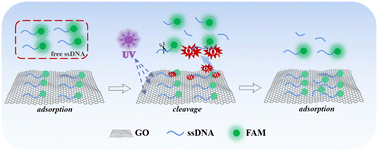DNA damage caused by light-driven graphene oxide: a new mechanism†
Abstract
Graphene oxide, a typical two-dimensional carbon-based nanomaterial, has been broadly applied in different industries because of its unique mechanical, electric, and thermal properties. These extensive applications will unavoidably release graphene oxide into the natural environment. In order to further evaluate the environmental behavior and environmental toxicity of graphene oxide, we systematically investigated the interaction mechanism between graphene oxide and DNA molecules, particularly the light-driven graphene oxide for DNA damage. Under light irradiation conditions, the graphene oxide has a strong cutting ability to DNA with different sequences. The cleavage behavior of DNA by graphene oxide mainly targets free DNA, which is similar to the degradation of non-adsorbed pollutants by nanomaterial catalysts. Both electron paramagnetic resonance and reactive oxygen species scavenging experiments indicated that 1O2 and O2˙− could be responsible for this DNA cleavage. In addition, the influence of several environmental factors (pH, metal ions, and biomolecules) on the cleavage reaction was investigated in detail. The results showed that these factors had little effect on the DNA-cutting reaction. This study provides novel insights into the potential environmental risk of graphene oxide.

- This article is part of the themed collections: Environmental Science: Nano Recent HOT Articles and Environmental fate of nanomaterials


 Please wait while we load your content...
Please wait while we load your content...